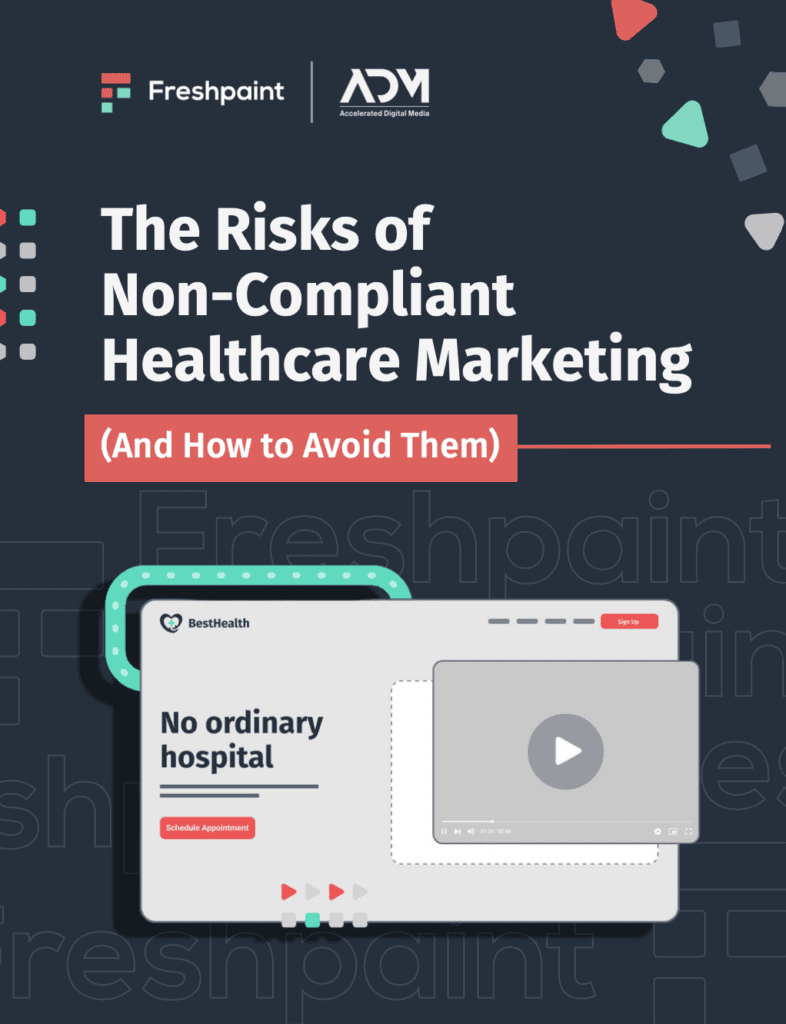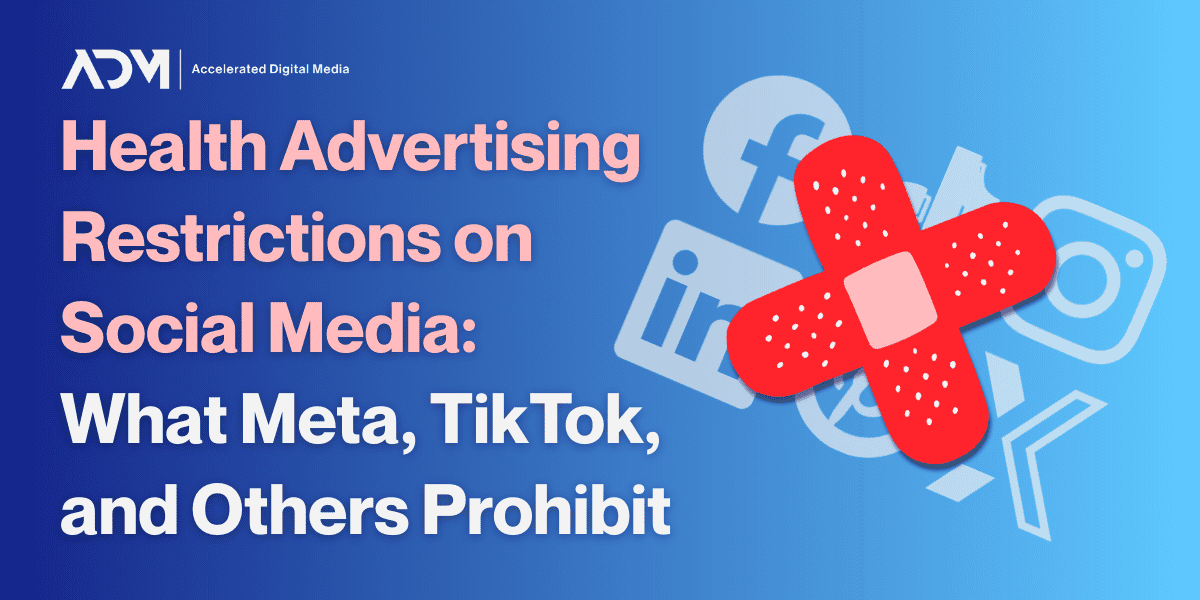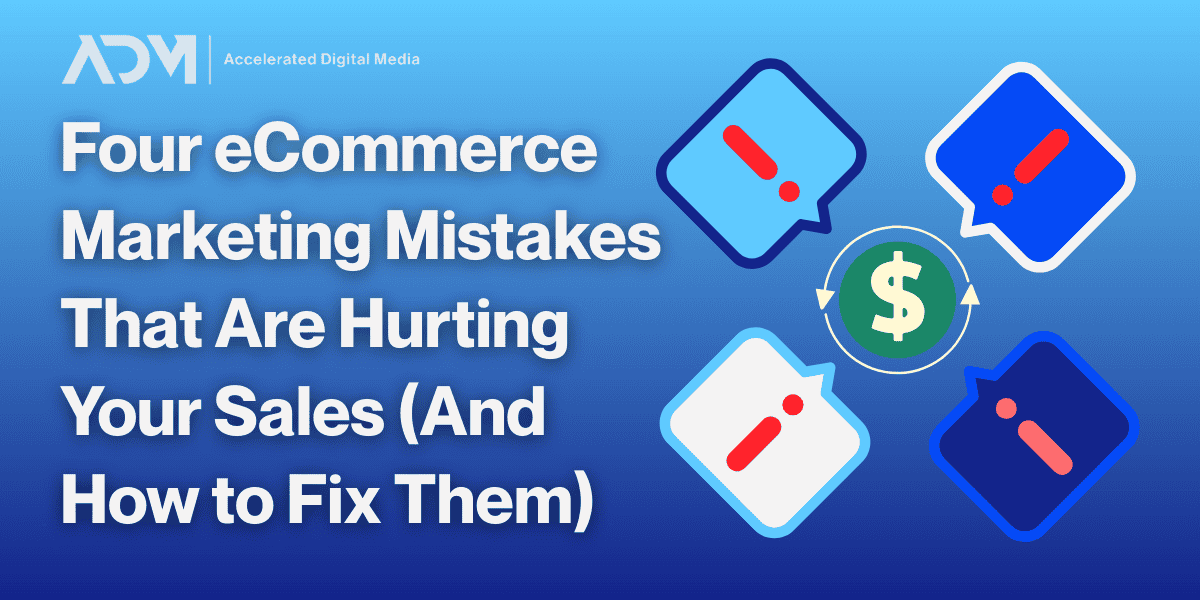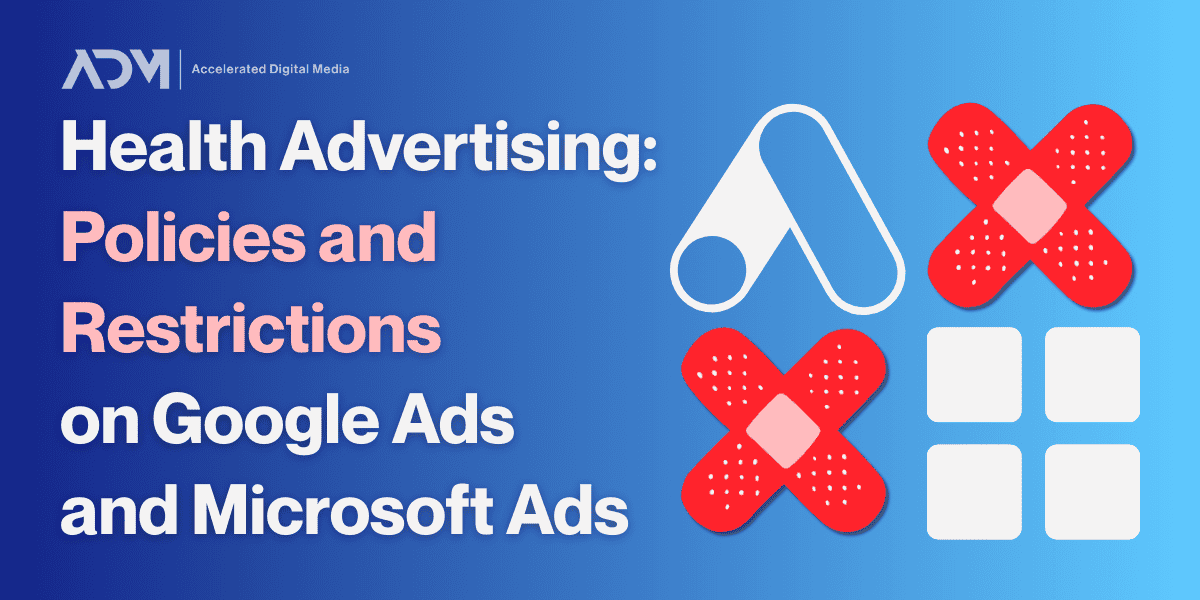Digital marketing for health and wellness brands is tricky. They face serious legal restrictions that limit their ability to use many tools available to digital advertisers in other industries. But given the sensitive nature of healthcare, these brands also have to be mindful of ever-changing platform policies that dictate how they can advertise on different social media services.
Failure to follow these policies can have consequences. Brands can have their ads limited or disapproved, or even have their accounts locked, if they flaunt the policies meant to keep these social platforms safe and non-invasive for users.
To make things simpler, ADM has assembled this guide to the noteworthy healthcare advertising policies across the leading social platforms. Recognize that these platform policies and are separate from, and not based on, the federal policies regarding PHI that deny the use of tracking pixels in most health applications.
Jump to Section:
- Meta Health Advertising Policies
- TikTok Health Advertising Policies
- X (formerly Twitter) Health Advertising Policies
- LinkedIn Health Advertising Policies
- Pinterest Health Advertising Policies
- Staying Compliant in Healthcare Social Marketing
Meta Ads Health Policies
Meta is the juggernaut of social media advertising. Meta Ads allows you to place across Instagram and Facebook—each with more than 2 billion monthly users—as well as other Meta properties like WhatsApp and Messenger. As the most pre-eminent social ad platform, it has extensive and evolving policies related to health, wellness, and pharmaceutical marketing. Its rules cover what brands are allowed to claim and say in their ads as well as what technologies they are allowed to deploy.
Ad Content Policies
Because of the sheer scope of its advertising suite, Meta has some of the most detailed health marketing content policies in the industry. As of 2025, policies restricting Facebook and Instagram health marketing include:
Personal Health and Appearance
Once called the Personal Health and Appearance policy, this Meta rule has been rolled into its larger Health and Wellness advertising guidelines. The rules state that advertisers must not run ads that generate “negative self-perception” as a means to promote health, wellness, or cosmetic products and procedures.
Cosmetic Procedures and Wellness Policy
Meta’s Cosmetic Procedures and Wellness rule dictates that advertisers not target users under the age of 18 with advertising related to:
- Weight loss products and services
- Cosmetic surgeries and procedures
- Dietary, health or herbal supplements
Online Pharmacies Policy
The Online Pharmacies rule is meant to ensure and pharmaceutical advertising on Facebook and Instagram is being done by reputable and verified pharmacies. All pharmaceutical advertisers might be LegitScript certified in order to tun their ads.
Personal Attributes Policy
Meta’s Personal Attributes Policy forbids brands from using their ads to assert or imply knowledge of a user’s personal attributes (including medical conditions). It largely discourages second-person language in ad copy (“Meet singles like you”; “Conquer your depression,” etc.) except in certain cases.
New Categorization and Advertising Restrictions
New for 2025, Meta has placed new limitations on how health and wellness brands use their advertising tools. All brands whose offerings are “associated with medical conditions, specific health statuses, or provider/patient relationships,” (read: all healthcare brands) are now subject to categorization and restriction based on the functions they are attempting to link to their Meta advertising.
Health and wellness brands are assessed either a partial or full restriction on their ability to optimize campaigns based off of certain lower-funnel conversion events, like sales or appointment bookings. Because linking user data to these conversions would likely constitute the creation of protected health information (PHI), this new rule is meant to enhance Meta’s prohibited information policy, which discourages brands from sharing certain user information with the company.
Partial restrictions apply to most health and wellness brands, while full restriction is primarily assessed to entities linking to sensitive web properties like patient portals. For a full primer on these new rules and how to stay compliant with them, read our conversation with Adam Putterman of Ours Privacy.
Meta’s policies are updated frequently, so it’s vital that health advertisers stay up-to-date on them.
EBOOK: THE RISKS OF NON-COMPLIANT HEALTH MARKETING
This eBook examines the stakes that healthcare companies face in their digital marketing efforts and offers valuable guidance on how to run compliant advertising.

TikTok Health Advertising Rules
Despite its wavering legal status, TikTok quickly became a social phenomenon, combining short form video with a rapidfire viewing experience and an impressively predictive algorithm. It’s also an increasingly-potent advertising option, even for health brands. In recent years, TikTok quickly built out restrictions and policies governing health advertising on its platform, though many lack the specificity outlined by other social platforms.
TikTok’s policies are country-specific. In the United States, all advertising related to any of the following must be targeted at users age 18 or older.
Prescription Advertising and Pharmacies
TikTok states that ads for prescription medicine may be allowed if advertisers provide “proof of approval and certification from appropriate local regional regulating authorities” (like the FDA).
Both brick-and-mortar and online pharmacies are allowed to advertise with proof of LegitScript or NABP certification.
Cosmetic Clinics and Surgeries
Where there are influencers there are cosmetic ads, so this is a particular area of focus for TikTok.
- Cosmetic clinics may advertise on TikTok provided they are locally certified and comply with all their local laws and regulations. TikTok mentions services like fillers and microdermabrasion services as allowable.
- Cosmetic surgeries may not be advertised on TikTok, with the exception of hair transplants.
Medical devices, OTC Medications, and Medical Institutions
Medical devices and over-the-counter (OTC) medications are fine to advertise on TIkTok provided that the products comply with all local laws and regulations and have FDA approval where necessary. Medical institutions can advertise if they are in compliance with all local laws and regulations.
Sexual Health Products
This is the one TikTok policy that invokes specific content restrictions. Products like condoms and lubricant may be advertised on TikTok, so long as they are not targeted at users under 18 and that ad content is not “overtly sexual” and does not “focus on sexual pleasure.”
Like Meta, TikTok explicitly asks brands not to use its tracking technology to collect healthcare information.
X’s Health and Pharmaceutical Policies
The platform once called Twitter has experienced some advertiser flight, but it’s still a major player in social media marketing. Now called X, it has a large healthcare policy section that covers restrictions unique to different countries around the world. Its primary policy is actually a list of exceptions: “Unless listed below, the promotion of health and pharmaceutical products and services is prohibited,” X’s site states.
Exceptions to X’s Health Advertising Bans
Exceptions include:
- Telemedicine advertising, provided the brand only advertisers in states it can operate and seeks prior authorization form X
- Advertisements for brick-and-mortar pharmacies provided they don’t promote the online sale of pharmaceuticals
- Advertisements for FDA-approved medical devices
- Advertisements from NABP-accredited online pharmacies
To view the full list of restrictions and exceptions, view X’s Healthcare policy page. The company also prohibits the creation of custom audiences or conversion events based off of sensitive information, including health information.
LinkedIn’s Healthcare Advertising Policy
LinkedIn Ads is a highly-underrated marketing tool for brands in many industries—and is particularly useful for B2B advertising. But after being named in class action suits for allegedly enabling improper PHI sharing, LinkedIn has begun to add some additional restrictions. Currently, it “reserves the right to restrict advertising related to any health matter.”
LinkedIn’s stated health ad policies include:
Insight Tag Restrictions
As a result of the aforementioned class action suits, LinkedIn decided in late 2024 to block usage of its Insight Tag (not unlike a Meta Pixel) on healthcare-related domains, or any others that may transmit what it classifies as Sensitive Data.
Healthcare Ads Policy
LinkedIn has a fairly comprehensive and consolidated Healthcare Ads Policy that outlines rules for what health products and services can be marketed on the platform, and under what conditions. Unlike other platforms, LinkedIn does have specific policies that relate to healthcare policy awareness advertising and clinical trial recruitment.
Health and Weight Loss Content Policy
LinkedIn also outlines specific content guidelines for health and weight loss ads, which discourage ads that promote misleading health info, “idealize or criticize” someone’s physical attributes, nor “promote or reinforce” negativity around body image or health conditions.
Pinterest’s Health and Wellness Advertising Restrictions
Pinterest is an intriguing, cost-effective, and highly-visual social platform with a devoted user base that appeals to many health and lifestyle brands. It also has some of the most straightforward, unique, and restrictive health advertising policies of all. For healthcare and wellness ads on Pinterest, brands may not:
- Target audiences based on sensitive health or medical conditions
- Advertise many health services, including clinical trials, direct-to-consumer genetic tests, paternity tests, and more
Weight Loss Advertising Ban
While other social platforms attempt to mitigate negative feelings created by weight loss-related advertising, Pinterest takes a novel approach: It completely rejects any ads on the subject. Since 2021, the platform has banned all weight loss imagery and language entirely from its advertising.
With prior platform approval, and subject to certain restrictions, Pinterest does allow marketing from online pharmacies, pharmaceutical manufacturers, and telehealth providers.
Staying Compliant in Healthcare Social Marketing
It’s vital to ensure you’re up-to-date on the health advertising policies on every social platform in your brand’s digital marketing portfolio if you want to keep your account in good standing. The last thing you want are negligent ad disapprovals that slow down your growth marketing strategy. And even more importantly, stay in tune with the latest in health advertising news, because worse still than a locked ads account would be a seven-figure fine.
For help navigating the ins and outs of health digital marketing, it may be wise to partner with an agency that specializes in healthcare. Reach out to the ADM team today if you’re looking for compliant marketing success.
DISCLAIMER
This content is for informational use only and is based on analysis of current platform policies related to health advertising. These policies are subject to change following this publication date. If you require legal advice about any of the matters discussed above, ADM recommends seeking a healthcare privacy attorney.




